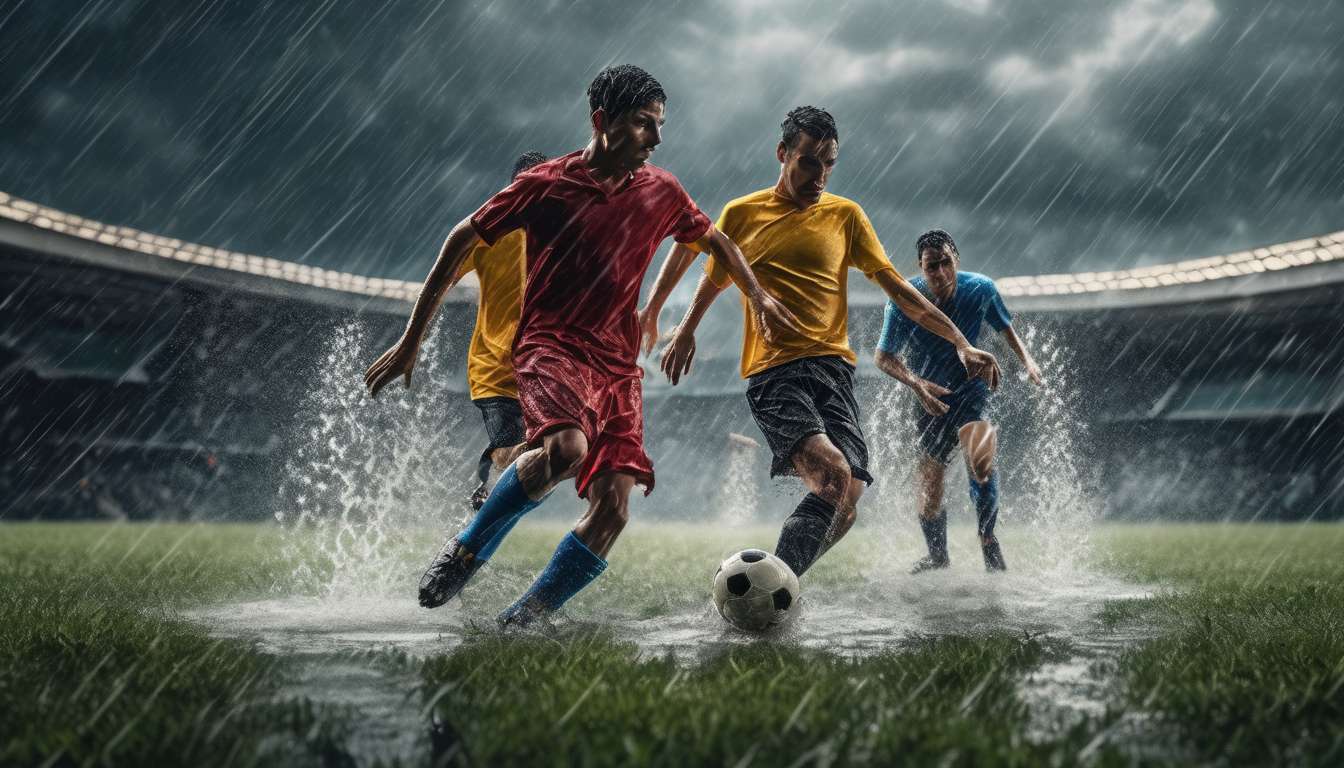In the ever-evolving world of sports, we find ourselves at the intersection of passion and economics, where market value and performance often tell two different stories. Our fascination with athletes and teams is not just driven by their prowess on the field, but also by the intriguing dynamics of their financial worth.
As we delve into the realm of sports economics, we aim to explore how market value is determined and how it correlates—or sometimes fails to correlate—with actual performance.
Together, we will examine the factors that inflate or deflate an athlete’s market value, such as:
- Media presence
- Endorsements
- Fan following
These factors sometimes overshadow on-field achievements.
By analyzing case studies across various sports, we hope to uncover insights into whether financial investments truly translate into success.
As we embark on this journey, we invite you to question and understand the intricate balance between market value and performance in sports.
The Influence of Media Presence
Media Presence and Athlete’s Market Value
Media presence significantly impacts an athlete’s market value by amplifying their visibility and public perception. This visibility transforms their names into household brands, making them more attractive to potential endorsers. It’s fascinating how media can shape an athlete’s story, highlighting their performance and achievements, which in turn boosts their market value.
Influence of Media on Athlete Performance
- Athletes’ performances are magnified through media channels.
- This influence affects both fan perception and brand evaluation of an athlete’s potential reach.
- A strong performance, coupled with significant media coverage, can propel athletes into the limelight, increasing their market value exponentially.
Community Engagement
As a community, we rally behind these athletes, cheering for their successes and sharing in their journeys. Thus, media presence becomes a crucial factor in determining an athlete’s market value, creating opportunities that extend beyond the arena.
Impact of Endorsements on Value
Endorsements play a pivotal role in shaping an athlete’s financial and brand value by aligning them with influential companies and products. These partnerships not only boost an athlete’s market value but also enhance their public image.
Mutual Benefits:
- When an athlete excels in performance, they become appealing to brands seeking to amplify their reach.
- This mutual relationship elevates both the athlete and the brand, creating a cycle of growth and increased recognition.
Financial Impact:
- Endorsements can sometimes surpass an athlete’s earnings from their sport alone, impacting their overall market value significantly.
- When athletes perform well, they attract more lucrative endorsement deals.
- These deals can boost their motivation and performance levels, creating a sense of belonging and pride, knowing that their hard work is recognized and rewarded.
Beyond Financial Gain:
- Endorsements aren’t just about financial gain; they’re about building relationships that resonate with fans and consumers.
- They foster a deeper connection between the athlete, the brand, and the community.
By understanding these dynamics, we see how endorsements contribute not only to an athlete’s success but also to their legacy and influence.
Fan Following: A Valuable Asset
A strong fan following not only elevates an athlete’s market value but also solidifies their influence and reach in the sports industry. We know that fans are the heart of sports. They provide athletes with an unparalleled platform, boosting their visibility and appeal.
When athletes captivate audiences, their market value naturally increases. This surge in popularity often leads to lucrative endorsements, as brands seek to tap into the athletes’ vast fan networks.
Our connection with athletes extends beyond their performance on the field.
- We cheer for them, share their triumphs, and stand by them during challenges.
- This bond amplifies their market value, as loyal fans become brand advocates, influencing purchasing decisions.
- Endorsements, in turn, reward athletes for their ability to engage and maintain a dedicated fan base.
Together, we create a community where athletes thrive. Our support not only enhances their performance but also ensures they remain influential figures in sports, continuously impacting the market on and off the field.
Market Value vs On-Field Performance
Balancing an athlete’s market value with their on-field performance presents a complex challenge in sports economics. We often ask if an athlete’s high market value aligns with their actual performance on the field. While endorsements can inflate an athlete’s perceived worth, it’s crucial that their performance justifies their valuation.
When athletes excel, they naturally draw attention not just from fans, but from brands eager to associate their products with success. This synergy can boost an athlete’s market value considerably.
However, what happens when performance dips? We must consider how endorsements and market value are impacted. The pressure to maintain a high level of play can be immense, as a drop in performance might lead to a decrease in market value.
As part of a community that thrives on shared victories and challenges, we recognize that aligning these factors isn’t just about numbers—it’s about maintaining trust and authenticity in the athlete’s journey.
Let’s continue to support this delicate balance.
Factors Inflating Athletes’ Worth
Several factors, including media exposure and brand partnerships, significantly inflate athletes’ worth beyond their on-field achievements.
We all know that an athlete’s market value isn’t solely determined by their performance statistics. Instead, their visibility and influence play crucial roles.
When athletes gain massive media exposure, they become household names, drawing in both loyal fans and lucrative endorsements. These endorsements often surpass their salaries, further elevating their market value.
We see this in the way brands strategically align themselves with athletes who resonate with the public. It’s not just about what they do on the field; it’s about their entire persona—how they engage with fans and the media.
In this connected world, athletes’ social media presence amplifies their appeal. As a community, we rally behind these figures who inspire us, driving their worth higher. It’s a dynamic relationship where our collective admiration significantly boosts their perceived value, creating an economic ecosystem beyond pure athletic performance.
The Role of Team Success
Team success dramatically impacts an athlete’s market value by enhancing their reputation and increasing their visibility on larger stages. When teams thrive, players’ performances become part of a compelling narrative of victory and camaraderie.
This elevated status can lead to lucrative endorsements, as brands seek to associate themselves with winners, further boosting athletes’ market values.
An athlete’s performance on a successful team contributes to a ripple effect that resonates with both fans and sponsors. This shared success fosters a sense of belonging and pride within the community, amplifying the athlete’s market value as their achievements are celebrated and remembered.
Moreover, team success often results in more media coverage, providing athletes with increased exposure and a larger platform to showcase their skills.
This increased visibility translates into:
- Greater recognition
- Higher market value
In summary, the interplay between team success, media coverage, and community pride significantly enhances an athlete’s market value.
Case Studies Across Sports
Basketball: LeBron James
LeBron James exemplifies how a player’s market value can skyrocket through performance and endorsements.
- His on-court success has directly correlated to lucrative deals with major brands.
- These endorsements have exponentially enhanced his financial footprint.
Soccer: Cristiano Ronaldo
Cristiano Ronaldo’s market value soared not only from his performance but also from his global endorsements.
- Strategic partnerships with well-known brands have made him a household name.
- His standing as an icon in the sport is solidified by these collaborations.
Tennis: Serena Williams
Serena Williams’ dominance on the court and strategic endorsements have significantly increased her market value.
- Her performance has inspired countless fans.
- Brand collaborations have broadened her influence beyond tennis.
Conclusion
These examples illustrate how athletes’ market values often reflect their performance and the power of endorsements.
- Success in sports goes beyond just winning games.
Success: Money Talks or Walks?
In the world of sports, financial success often mirrors athletic achievements and strategic brand partnerships. When athletes perform at their peak, their market value skyrockets. This phenomenon is not just about scoring goals or winning matches; it’s about crafting a personal brand that resonates globally.
Endorsements play a crucial role in this dynamic, allowing athletes to leverage their on-field performance into off-field profitability. This creates a cycle where:
- Performance boosts market value.
- Increased market value enhances the ability to secure lucrative endorsements.
Our communities rally around these sports icons, and their success feels like our success. We cheer not only for points scored but also for every endorsement deal that validates their market value. It’s a symbiotic relationship where performance and market value are intertwined.
Together, as fans, we witness how an athlete’s market value can walk the walk with their performance, proving that in sports, money does talk. It speaks volumes about the athlete’s influence and our collective belief in their prowess.
How does the age of an athlete influence their market value and performance projections?
Age and Market Value
Age is a critical factor in determining an athlete’s market value. Younger players are often perceived as having greater potential for growth and development, making them highly desirable in the market.
Performance Projections Based on Age
Performance projections are also influenced by an athlete’s age due to several factors:
-
Experience: Older athletes may have more experience, which can enhance their decision-making and strategic play.
-
Physical Condition: Age can affect an athlete’s physical abilities, with younger athletes generally having better endurance and recovery rates.
-
Career Longevity: Younger athletes are typically seen as having a longer career ahead, which can be attractive to teams looking for long-term investments.
Recognizing the interplay between age, market value, and performance is essential for teams and agents when making strategic decisions.
What role do injuries play in determining an athlete’s market value?
Injuries are a crucial factor in shaping an athlete’s market value. When a player is frequently sidelined due to injuries, their value can decrease significantly.
Impact on Marketability:
- Teams may be less willing to invest in a player with a history of health issues.
- This can impact the athlete’s overall marketability.
Maintaining Physical Well-being:
- It’s essential for athletes to maintain their physical health to secure their market value.
- Staying healthy helps athletes remain competitive in the sports industry.
How is the market value of athletes in niche sports determined compared to those in mainstream sports?
When examining how the market value of athletes in niche sports is determined compared to those in mainstream sports, it’s fascinating to observe the different factors that influence their valuation.
Niche Sports:
- Rely on a dedicated fan base.
- Leverage unique sponsorship opportunities to drive market value.
Mainstream Sports:
- Benefit from larger audiences.
- Enjoy extensive media coverage.
Understanding these distinctions can help us appreciate the diverse ways athletes in various sports establish their worth.
Conclusion
In the world of sports economics, market value and performance are intertwined but not always synonymous.
Factors Influencing an Athlete’s Worth:
- Media Presence: Athletes who frequently appear in the media tend to have higher market values due to increased visibility.
- Endorsements: Deals with brands can significantly boost an athlete’s financial worth beyond their salary.
- Fan Following: A large fan base can elevate an athlete’s market value, as it often leads to higher merchandise sales and more lucrative sponsorship deals.
On-Field vs. Off-Field Success:
- While on-field success is crucial, off-field factors such as personal branding and public persona can inflate an athlete’s value.
- Team success also impacts an athlete’s market value, as winning teams often have players with higher marketability.
Conclusion:
Through case studies, it is evident that in sports economics, the intersection of money and success is complex. This complexity highlights the multi-faceted nature of evaluating athletes in today’s market, where both performance and external factors contribute to their overall worth.










